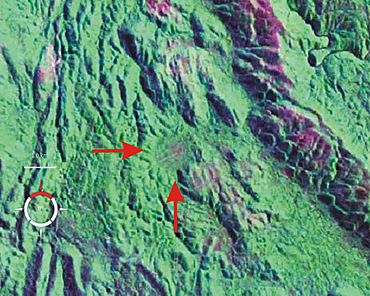Darwin Crater facts for kids
Quick facts for kids Darwin CraterTasmania |
|
|---|---|

False-colour Landsat image of Darwin Crater (arrowed); screen capture from NASA World Wind
|
|
The Darwin Crater is a special place in Tasmania, Australia. Scientists believe it was formed by a meteorite crashing into Earth a very long time ago. It's located in Western Tasmania, about 26 km (16 mi) south of Queenstown. You can find it inside the Franklin-Gordon Wild Rivers National Park.
This crater looks like a big, flat, circular dip in the ground, about 1.2 km (0.75 mi) wide. It's surrounded by mountains and thick forests.
Contents
How Was Darwin Crater Found?
The Discovery of a Hidden Crater
A geologist named R. J. Ford discovered the Darwin Crater in 1972. He was searching for the origin of a unique material called Darwin glass. This special glass is found spread out over more than 400 square kilometers (150 sq mi) in southwestern Tasmania.
What's Inside the Crater?
Scientists used special tools and drilled into the ground to learn more about the crater. They found that it's filled with up to 230 meters (750 ft) of broken rocks, called breccia. On top of these rocks are layers of sediment from an ancient lake that existed during the Pleistocene Ice Age.
Even though scientists haven't found a piece of the actual meteorite, many clues suggest it was an impact. The way the Darwin glass is connected to the crater, along with the layers of material inside, strongly supports the idea that a meteorite created it.
How Old is Darwin Crater?
Dating the Impact Event
If the Darwin Crater is indeed the source of the Darwin glass, then the crater is about 816,000 years old. Scientists figured this out by using a method called Argon-argon dating on the Darwin glass. This method helps them determine the age of rocks and minerals.
Life Surviving the Impact
Interestingly, scientists have found tiny pieces of plant material inside the Darwin glass. These pieces are like "biomarkers" – they show that parts of the local plants survived the huge impact! These include things like cellulose, lignin, and other plant parts, giving us clues about the ancient ecosystem.
Visiting Darwin Crater
Exploring the Crater Trail
There is a path that leads to the Darwin Crater. However, people who have visited say that the trail is not regularly looked after. It can be overgrown with plants and quite muddy in some areas.
Images for kids
See also
 In Spanish: Cráter Darwin para niños
In Spanish: Cráter Darwin para niños




